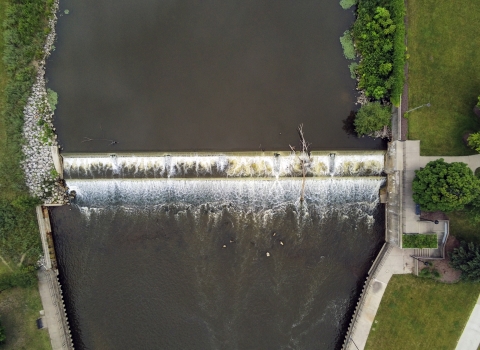Fisheries biologists from the U.S. Fish and Wildlife Service and partner organizations had been crossing their fingers for decades, hoping our careful, cumulative efforts would be enough for lake sturgeon to overcome the odds. And once again lake sturgeon showed their amazing resilience.
In April 2024, a vigilant angler led partners to discover first-ever evidence of lake sturgeon spawning on Missouri’s Osage River – an area where the species was wiped out more than a century ago. This comes after three consecutive years of successful spawning nearby on the Mississippi River as well.
These are the momentous discoveries we hold out hope for over the many years it takes to see results. The Osage spawning comes after 40 years-worth of reintroducing lake sturgeon fingerlings and ongoing monitoring to restore populations in the Missouri River basin. Because of the lake sturgeon’s slow maturity, it is possible – even likely – that the spawning activity we see now may be from fish reintroduced in the 1980s or 90s, during the earliest phase of this effort.
This is because it may take males up to 10 years, and females up to 30 years, to reach spawning age, and lake sturgeon also don’t spawn every year. What’s more, a host of obstacles get in the way of their migration over great distances to and from their natal rivers to spawn.
The Osage is one of the Missouri River’s largest tributaries, but it was dramatically altered when Bagnell Dam was constructed for hydroelectricity in 1931, making most of it inaccessible to migrating fish like lake sturgeon. The Bagnell and Truman Dam, constructed on the Osage in 1979, generate power for the St. Louis metropolitan area.
While dams present a big challenge to lake sturgeon restoration overall, it’s still possible to make progress in other ways. Working alongside partners such as the Missouri Department of Conservation, the U.S. Geological Survey and U.S. Army Corps of Engineers, biologists from our Columbia Fish and Wildlife Conservation Office build on one increment of success at a time.
In fact, all of our fish and wildlife conservation offices throughout the species’ wide range monitor reintroduced lake sturgeon that we implant with telemetry tags. A massive amount of data is collected and analyzed this way, informing all aspects of the broader restoration program.
Where we can’t deconstruct or retrofit dams with fish pathways, we work together with partners to adjust locks and gates for favorable flow and temperature for spawning, clean up polluted waterways and restore rock and gravel beds. All along we keep monitoring, sharing information, expertise and resources with partners and refining activities as we go. Together, these efforts give lake sturgeon better odds of surviving to maturity and reproducing – and eventually becoming self-sustaining.
This spring, our biologists accompanied a researcher from the Missouri Fish and Wildlife Cooperative Research Unit at the University of Missouri for monitoring in the Missouri River basin. Using trotlines and gill nets, we captured a couple dozen lake sturgeon, collecting blood samples, recording lifecycle information and checking for telemetry tags. Toward the end of these surveys, an angler notified the researcher of apparent spawning, which partners were then able to verify.
The massive, long-lived, prehistoric-looking lake sturgeon was once abundant throughout the eastern and central United States and Canada, stretching all the way south to the Mobile River basin and throughout the Great Lakes, Hudson Bay and Mississippi River basins. After surviving for 150 million years on Earth, the species was decimated in a matter of decades from over-harvest and intentional killing as nuisance fish around the turn of the 20th century. Ever since careful harvest regulations were put in place over a century ago, we and our partners have focused on stocking, monitoring and restoring access to healthy habitats in large rivers and lakes in various areas throughout lake sturgeon’s range in 24 states and five Canadian provinces.




